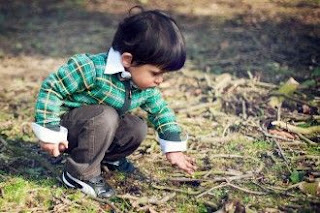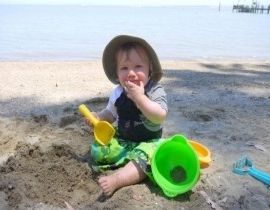Babies smile even in the womb, a gesture that expresses welfare and, from the second half of life, satisfaction also. Laughter is a sign that the child enjoys good times and improves also your mood. The laughter has benefits for the baby explain that, in addition to enjoying the laughter when it occurs spontaneously, promote appropriate also. The following article lists infallible five games that they make the baby laugh.
Laughter is little sign that enjoys
The laughter is one of the main signs to know that someone is in good health and enjoying a good time, also generates many Positive effect in the body as it raises endorphin levels, increases heart rate and exercise muscles. In the case of the Laughing Baby, Is one of the most enjoyable and pleasant sounds that can be heard a father or a mother.
The baby begins to smile in the womb
During the first months of life, the baby do not laugh, but smiles. The Ultrasounds, For observing the child in the womb, show how small smile. And after birth, so do their sleep. These are gestures that reveal unconscious feelings of well being in the baby. About four or five months, start to make sounds like laughter and a few months later, his laugh and also expresses satisfaction.
The laughter has benefits for the baby
Baby Laughter strengthens the bond with parents
This explains why parents should not simply wait for the laughter spontaneous child But, also, be promote. This is important "not only for what it means to laugh in itself but also by generating bonding with parents," says Almudena logopeda Valley, Emeritus of Clinical Neuro, Merida.
The expert stresses how important it is to promote the bond with the baby. To do this, nothing better than a few games that cause the laughter of small and giant smiles in adults.
Five games that achieve infallible the baby laugh
The games designed to cause Laughing Baby should, as a rule, include eye contact between the child and the adult. Alternatives are infinitive: the limit is one's imagination and creativity. Should also be attentive to discover, sometimes by accident, gestures or situations that make the child laugh. It may be a face, imitating a movement, a word that is funny, etc..
The games listed below (some of them true classics), tend to be infallible when it comes to finding the baby laugh.
1. It is one of the classic games ,The adult is hidden and then reappears in the eyes of baby, Which explodes in a laugh. No need to go to another place to hide: just to cover your face with a handkerchief, with another object or even by hand. A finding that the person is still there, though not seen, is infallible: the small loves and can laugh for hours by repeating the trick.
For baby, check that the person is still there fascinating hidden
There is a variant: the simulated adult that something obstructs the view of the baby and, because of that, he is not. This version encourages small to assume a more active role, as it will start to move and make sounds to help you find adult.
2. The mirror. Is a variant of game above. The difference is that in this case, which is hidden and is not then reappears adult, but the image baby reflected in a mirror. Before their first birthday, the young tend to believe that the reflection you see is actually another child and, therefore, the mirrors are very attractive.
If the adult places the baby in the mirror, he departs and then put him back in front, the result will also cause your laughter. Can also introduce variants, such as changing the appearance of something baby, or your own (if also reflected). Some items that can help this "transformation" is a hat or scarf placed on the head, among others.
3. Tickle. This is very personal: each person feels the tickling to varying degrees and in different parts of his body. A few Babies like more than others. So it is up to the parents to know their children and learn what your favorite: soft caresses the neck or feet, kisses and raspberries on the belly, etc..
The next step is to up stories that end with a tickle. A classic is to create a narrative, what did each finger indicating "one found an egg, someone else cooked, another hair". In these cases, an action is improvised for the last finger as evidence that the story ends with a pleasant tickling the baby's body and, therefore, their guffaw.
Another possibility is situated at a distance of small and start counting from that position, the story of an animal that approaches another. While the adult continues his story, this is closer to the baby until he reaches. The story ends when the little laugh. These games fascinate the child, To enjoy, even more, of the previous expectation created, which tickled the end themselves.
4. Flights in the air. Is to raise the little guy safe and bring the sides to go different places, as if flying. At Babies I really like these rides. The first reaction, in general, be silent, and discovering new perspectives. The child begins to laugh when the "flight" begins to have incidents like abrupt descents, address changes, failed attempts to reach a goal and everything that the adult to direct the path comes to mind.
5. Whirlpool. Many kids love the water and enjoy when receiving a bath. Other small, however, do not enjoy their spare room in the same way, and this can cause Tantrums and moodiness. In all cases, but particularly the latter, you can find alternatives to make bath time fun.
Something that can help is to introduce toys in the tub (rubber ducks, sponges of different colors, etc..) But there is also this possibility: the tub. It takes a fairly large tube, which can be used as straw or blowgun. Introduces one end underwater and is blown through the other. The bubbles rise to the surface will make the baby, You'll want to catch them. If the end of the tube is placed attached to small bubbles will make tickle: the small laugh bath time and also be an amusement space.






























